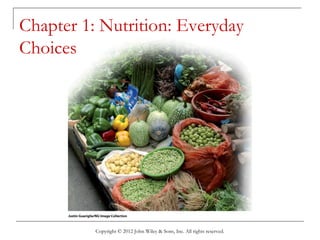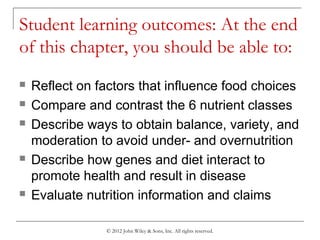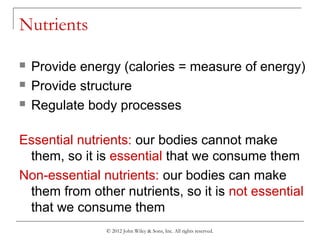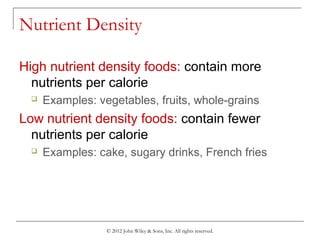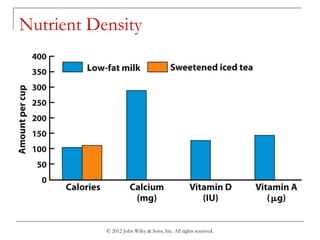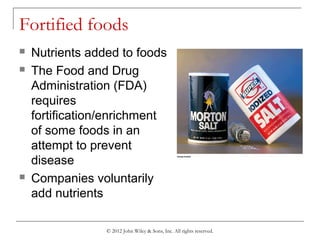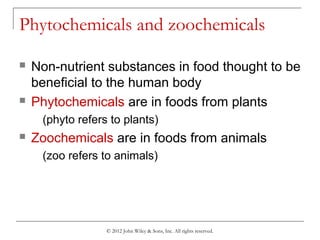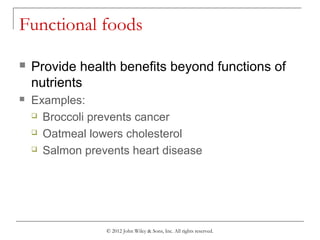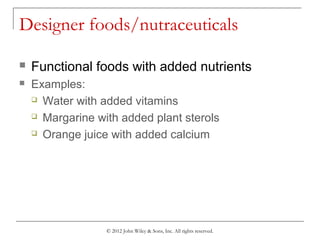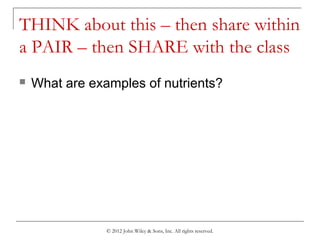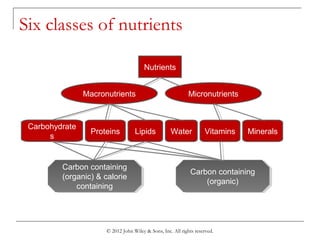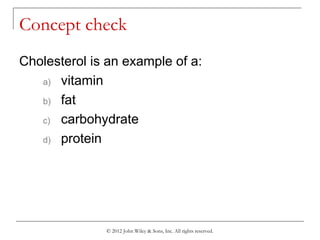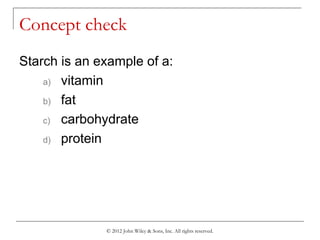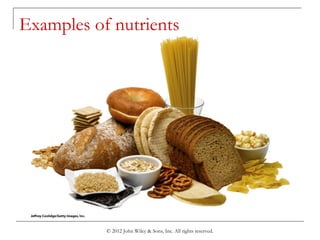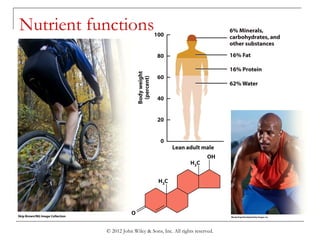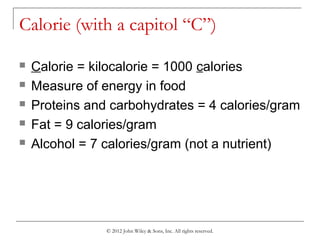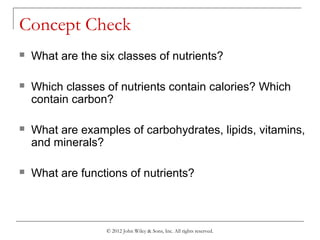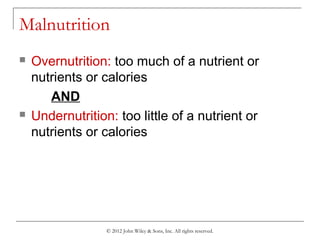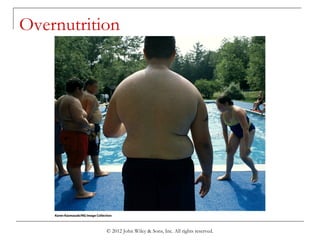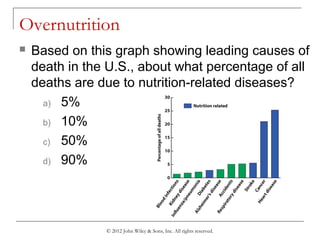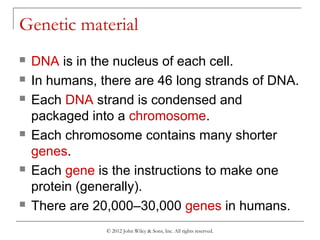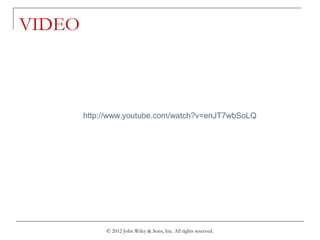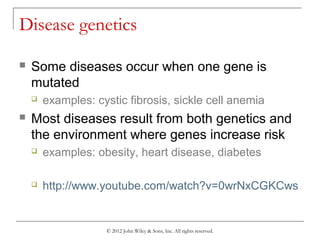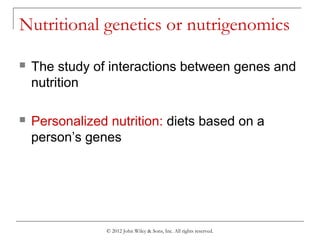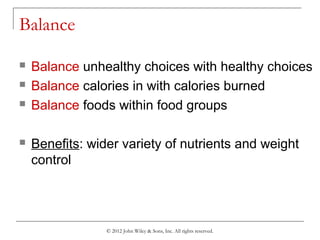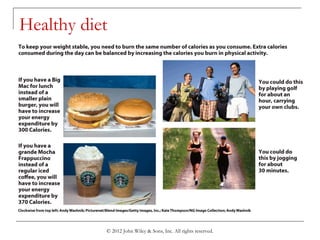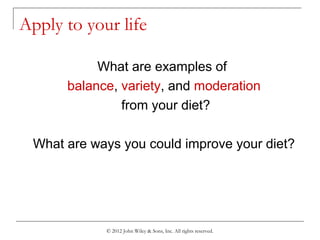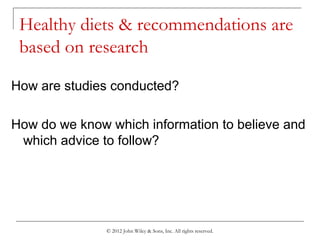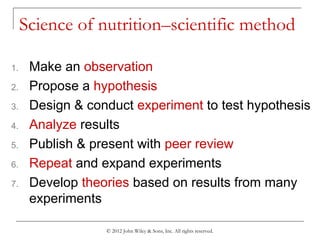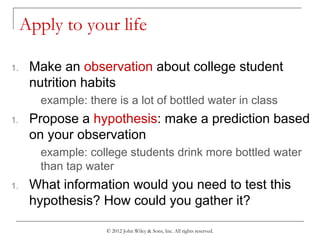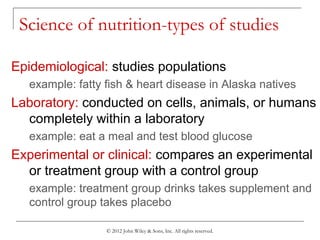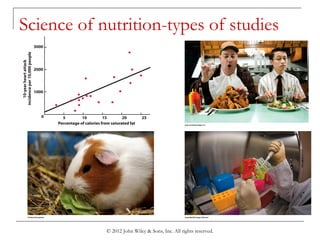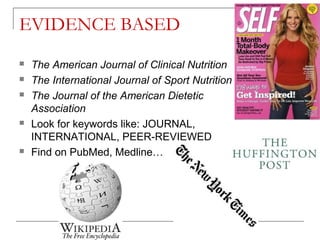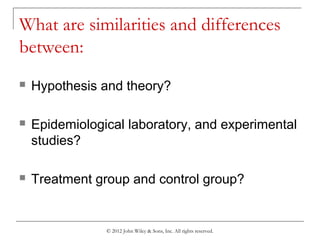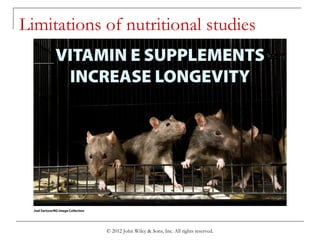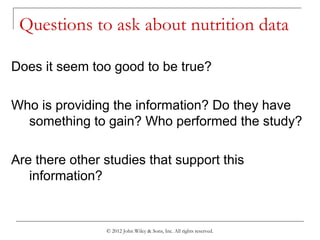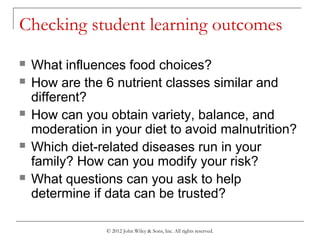Ch01 edited
- 1. Copyright ┬® 2012 John Wiley & Sons, Inc. All rights reserved. Chapter 1: Nutrition: Everyday Choices
- 2. ┬® 2012 John Wiley & Sons, Inc. All rights reserved. Student learning outcomes: At the end of this chapter, you should be able to: ’ü« Reflect on factors that influence food choices ’ü« Compare and contrast the 6 nutrient classes ’ü« Describe ways to obtain balance, variety, and moderation to avoid under- and overnutrition ’ü« Describe how genes and diet interact to promote health and result in disease ’ü« Evaluate nutrition information and claims
- 3. ┬® 2012 John Wiley & Sons, Inc. All rights reserved. Nutrients ’ü« Provide energy (calories = measure of energy) ’ü« Provide structure ’ü« Regulate body processes Essential nutrients: our bodies cannot make them, so it is essential that we consume them Non-essential nutrients: our bodies can make them from other nutrients, so it is not essential that we consume them
- 4. ┬® 2012 John Wiley & Sons, Inc. All rights reserved. Nutrient Density High nutrient density foods: contain more nutrients per calorie ’ü▒ Examples: vegetables, fruits, whole-grains Low nutrient density foods: contain fewer nutrients per calorie ’ü▒ Examples: cake, sugary drinks, French fries
- 5. ┬® 2012 John Wiley & Sons, Inc. All rights reserved. Nutrient Density
- 6. ┬® 2012 John Wiley & Sons, Inc. All rights reserved. Nutrient Density
- 7. ┬® 2012 John Wiley & Sons, Inc. All rights reserved. Apply to your life What are examples of low nutrient density foods in your diet? What are examples of high nutrient density foods in your diet? How could you replace high nutrient density foods with low nutrient density foods in your diet?
- 8. ┬® 2012 John Wiley & Sons, Inc. All rights reserved. Fortified foods ’ü« Nutrients added to foods ’ü« The Food and Drug Administration (FDA) requires fortification/enrichment of some foods in an attempt to prevent disease ’ü« Companies voluntarily add nutrients
- 9. ┬® 2012 John Wiley & Sons, Inc. All rights reserved. Phytochemicals and zoochemicals ’ü« Non-nutrient substances in food thought to be beneficial to the human body ’ü« Phytochemicals are in foods from plants (phyto refers to plants) ’ü« Zoochemicals are in foods from animals (zoo refers to animals)
- 10. ┬® 2012 John Wiley & Sons, Inc. All rights reserved. Phytochemicals
- 11. ┬® 2012 John Wiley & Sons, Inc. All rights reserved. Functional foods ’ü« Provide health benefits beyond functions of nutrients ’ü« Examples: ’ü▒ Broccoli prevents cancer ’ü▒ Oatmeal lowers cholesterol ’ü▒ Salmon prevents heart disease
- 12. ┬® 2012 John Wiley & Sons, Inc. All rights reserved. Designer foods/nutraceuticals ’ü« Functional foods with added nutrients ’ü« Examples: ’ü▒ Water with added vitamins ’ü▒ Margarine with added plant sterols ’ü▒ Orange juice with added calcium
- 13. ┬® 2012 John Wiley & Sons, Inc. All rights reserved. Concept Check ’ü« How are essential and non-essential nutrients similar and different? ’ü« What are benefits of high nutrient density foods? ’ü« How are fortified foods, functional foods, and designer foods similar and different? What are examples of each?
- 14. ┬® 2012 John Wiley & Sons, Inc. All rights reserved. THINK about this ŌĆō then share within a PAIR ŌĆō then SHARE with the class ’ü« Think about foods you have consumed in the last week. What influenced your choices? ’ü« What is the strangest food you have consumed (by American standards)? ’ü« Describe a celebration in your family. Who would be there? What would you do?
- 15. ┬® 2012 John Wiley & Sons, Inc. All rights reserved. THINK about this ŌĆō then share within a PAIR ŌĆō then SHARE with the class ’ü« What are examples of nutrients?
- 16. ┬® 2012 John Wiley & Sons, Inc. All rights reserved. Six classes of nutrients Nutrients Carbohydrate s Macronutrients Proteins Micronutrients Lipids Water Vitamins Minerals Carbon containing (organic) & calorie containing Carbon containing (organic) & calorie containing Carbon containing (organic) Carbon containing (organic)
- 17. ┬® 2012 John Wiley & Sons, Inc. All rights reserved. Examples of nutrients Nutrients Carbohydrate s Proteins Lipids/ Fats Water Vitamins Minerals Starch Sugar Fiber Saturated fat Monounsaturated fat Polyunsaturated fat Cholesterol A, D, E, K, C, B12 Sodium Calcium Fluoride Folic acid Niacin
- 18. ┬® 2012 John Wiley & Sons, Inc. All rights reserved. Concept check Which of the following does NOT contain calories? a) vitamins b) fats c) carbohydrates d) proteins
- 19. ┬® 2012 John Wiley & Sons, Inc. All rights reserved. Concept check Cholesterol is an example of a: a) vitamin b) fat c) carbohydrate d) protein
- 20. ┬® 2012 John Wiley & Sons, Inc. All rights reserved. Concept check Starch is an example of a: a) vitamin b) fat c) carbohydrate d) protein
- 21. ┬® 2012 John Wiley & Sons, Inc. All rights reserved. What are similarities and differences between: ’ü« Carbohydrates, proteins, fats, water, vitamins, and minerals?
- 22. ┬® 2012 John Wiley & Sons, Inc. All rights reserved. Examples of nutrients
- 23. ┬® 2012 John Wiley & Sons, Inc. All rights reserved. Examples of nutrients
- 24. ┬® 2012 John Wiley & Sons, Inc. All rights reserved. Examples of nutrients
- 25. ┬® 2012 John Wiley & Sons, Inc. All rights reserved. Nutrient functions ’ü« Provide energy (calories) ’ü« Provide building blocks for structures ’ü« Bones, hair, skin ’ü« Cell membranes and structures ’ü« Regulate body processes ’ü« Body temperature ’ü« Blood pressure ’ü« Hormones and cell communication ’ü« Speed up reactions
- 26. ┬® 2012 John Wiley & Sons, Inc. All rights reserved. Nutrient functions
- 27. ┬® 2012 John Wiley & Sons, Inc. All rights reserved. Calorie (with a capitol ŌĆ£CŌĆØ) ’ü« Calorie = kilocalorie = 1000 calories ’ü« Measure of energy in food ’ü« Proteins and carbohydrates = 4 calories/gram ’ü« Fat = 9 calories/gram ’ü« Alcohol = 7 calories/gram (not a nutrient)
- 28. ┬® 2012 John Wiley & Sons, Inc. All rights reserved. Concept Check ’ü« What are the six classes of nutrients? ’ü« Which classes of nutrients contain calories? Which contain carbon? ’ü« What are examples of carbohydrates, lipids, vitamins, and minerals? ’ü« What are functions of nutrients?
- 29. ┬® 2012 John Wiley & Sons, Inc. All rights reserved. Malnutrition ’ü« Overnutrition: too much of a nutrient or nutrients or calories AND ’ü« Undernutrition: too little of a nutrient or nutrients or calories
- 30. ┬® 2012 John Wiley & Sons, Inc. All rights reserved. Undernutrition
- 31. ┬® 2012 John Wiley & Sons, Inc. All rights reserved. Overnutrition
- 32. ┬® 2012 John Wiley & Sons, Inc. All rights reserved. Overnutrition ’ü« Based on this graph showing leading causes of death in the U.S., about what percentage of all deaths are due to nutrition-related diseases? a) 5% b) 10% c) 50% d) 90%
- 33. ┬® 2012 John Wiley & Sons, Inc. All rights reserved. THINK about this ŌĆō then share within a PAIR ŌĆō then SHARE with the class ’ü« What is DNA? Where is it located? ’ü« What is a chromosome? What is a gene? ’ü« How are traits inherited?
- 34. ┬® 2012 John Wiley & Sons, Inc. All rights reserved. Genetic material ’ü« DNA is in the nucleus of each cell. ’ü« In humans, there are 46 long strands of DNA. ’ü« Each DNA strand is condensed and packaged into a chromosome. ’ü« Each chromosome contains many shorter genes. ’ü« Each gene is the instructions to make one protein (generally). ’ü« There are 20,000ŌĆō30,000 genes in humans.
- 35. VIDEO ┬® 2012 John Wiley & Sons, Inc. All rights reserved. http://www.youtube.com/watch?v=enJT7wbSoLQ
- 36. ┬® 2012 John Wiley & Sons, Inc. All rights reserved. Human inheritance ’ü« There are 46 chromosomes or 23 pairs of chromosomes. ’ü« Each egg or sperm has one half of each chromosome pair, or 23 total chromosomes. ’ü« During fertilization, an egg and sperm fuse. ’ü« An embryo has 46 chromosomes: 23 from the father and 23 from the mother. ’ü« http://www.youtube.com/watch?v=gtPd4Yn_18c ’ü« http://www.youtube.com/watch?v=rgLJrvoX_qo
- 37. ┬® 2012 John Wiley & Sons, Inc. All rights reserved. Disease genetics ’ü« Some diseases occur when one gene is mutated ’ü▒ examples: cystic fibrosis, sickle cell anemia ’ü« Most diseases result from both genetics and the environment where genes increase risk ’ü▒ examples: obesity, heart disease, diabetes ’ü▒ http://www.youtube.com/watch?v=0wrNxCGKCws
- 38. ┬® 2012 John Wiley & Sons, Inc. All rights reserved. Disease genetics
- 39. ┬® 2012 John Wiley & Sons, Inc. All rights reserved. Ask yourself ’ü« Name 2 factors that can lead to weight gain? ’ü« Can you still become obese even if both of your parents are thin? Can you be very thin if your parents are not? ’ü« Do you believe you can be fat and fit?
- 40. ┬® 2012 John Wiley & Sons, Inc. All rights reserved. Nutritional genetics or nutrigenomics ’ü« The study of interactions between genes and nutrition ’ü« Personalized nutrition: diets based on a personŌĆÖs genes
- 41. ┬® 2012 John Wiley & Sons, Inc. All rights reserved. Healthy diet ’ü« Variety, Balance, Moderation ’ü« High in: ’ü▒ Fruits, vegetables, whole grains ’ü« Moderate in: ’ü▒ Calories, sodium, sugar ’ü« Low in: ’ü▒ Unhealthy fats (trans fats, saturated fats, cholesterol)
- 42. ┬® 2012 John Wiley & Sons, Inc. All rights reserved. Variety ’ü« Eating foods from a variety of food groups ’ü« Eating a variety of foods within each food group ’ü« Benefits: increased nutrients and phytochemicals, decreased toxins
- 43. ┬® 2012 John Wiley & Sons, Inc. All rights reserved. Balance ’ü« Balance unhealthy choices with healthy choices ’ü« Balance calories in with calories burned ’ü« Balance foods within food groups ’ü« Benefits: wider variety of nutrients and weight control
- 44. ┬® 2012 John Wiley & Sons, Inc. All rights reserved. Moderation ’ü« Moderate portion sizes ’ü« Moderate consumption of each food ’ü« Benefits: not too much of any nutrient or calories
- 45. ┬® 2012 John Wiley & Sons, Inc. All rights reserved. Healthy diet
- 46. ┬® 2012 John Wiley & Sons, Inc. All rights reserved. Apply to your life What are examples of balance, variety, and moderation from your diet? What are ways you could improve your diet?
- 47. ┬® 2012 John Wiley & Sons, Inc. All rights reserved. Healthy diets & recommendations are based on research How are studies conducted? How do we know which information to believe and which advice to follow?
- 48. ┬® 2012 John Wiley & Sons, Inc. All rights reserved. Science of nutritionŌĆōscientific method 1. Make an observation 2. Propose a hypothesis 3. Design & conduct experiment to test hypothesis 4. Analyze results 5. Publish & present with peer review 6. Repeat and expand experiments 7. Develop theories based on results from many experiments
- 49. ┬® 2012 John Wiley & Sons, Inc. All rights reserved. Apply to your life 1. Make an observation example: I received 3 compliments on my hair cut 1. Propose a hypothesis: make a prediction based on your observation example: my hair looks good when it is short; it will look better if it is even shorter 1. What information would you need to test this hypothesis? How could you gather it? example: cut hair shorter and notice compliments
- 50. ┬® 2012 John Wiley & Sons, Inc. All rights reserved. Apply to your life 1. Make an observation about college student nutrition habits example: there is a lot of bottled water in class 1. Propose a hypothesis: make a prediction based on your observation example: college students drink more bottled water than tap water 1. What information would you need to test this hypothesis? How could you gather it?
- 51. ┬® 2012 John Wiley & Sons, Inc. All rights reserved. Science of nutritionŌĆōscientific method
- 52. ┬® 2012 John Wiley & Sons, Inc. All rights reserved. Science of nutrition-types of studies Epidemiological: studies populations example: fatty fish & heart disease in Alaska natives Laboratory: conducted on cells, animals, or humans completely within a laboratory example: eat a meal and test blood glucose Experimental or clinical: compares an experimental or treatment group with a control group example: treatment group drinks takes supplement and control group takes placebo
- 53. ┬® 2012 John Wiley & Sons, Inc. All rights reserved. Science of nutrition-types of studies
- 54. ┬® 2012 John Wiley & Sons, Inc. All rights reserved. Types of nutritional information
- 55. EVIDENCE BASED ’ü« The American Journal of Clinical Nutrition ’ü« The International Journal of Sport Nutrition ’ü« The Journal of the American Dietetic Association ’ü« Look for keywords like: JOURNAL, INTERNATIONAL, PEER-REVIEWED ’ü« Find on PubMed, MedlineŌĆ”
- 56. Non-Peer Reviewed Reliable Resources ’ü« Myplate.gov ’ü« CA Dept of Public Health ’ü« Professional opinions based in facts/evidence ’ü▒ Nutritionunplugged.com & RD Blog Network ’ü▒ David Katz ŌĆō writes for Huffington Post ’ü▒ RD411.com ’ü▒ Local registered dietitians ┬® 2012 John Wiley & Sons, Inc. All rights reserved.
- 57. ┬® 2012 John Wiley & Sons, Inc. All rights reserved. What are similarities and differences between: ’ü« Hypothesis and theory? ’ü« Epidemiological laboratory, and experimental studies? ’ü« Treatment group and control group?
- 58. ┬® 2012 John Wiley & Sons, Inc. All rights reserved. Limitations of nutritional studies
- 59. ┬® 2012 John Wiley & Sons, Inc. All rights reserved. Questions to ask about nutrition data Does it seem too good to be true? Who is providing the information? Do they have something to gain? Who performed the study? Are there other studies that support this information?
- 60. ┬® 2012 John Wiley & Sons, Inc. All rights reserved. Checking student learning outcomes ’ü« What influences food choices? ’ü« How are the 6 nutrient classes similar and different? ’ü« How can you obtain variety, balance, and moderation in your diet to avoid malnutrition? ’ü« Which diet-related diseases run in your family? How can you modify your risk? ’ü« What questions can you ask to help determine if data can be trusted?
- 61. ┬® 2012 John Wiley & Sons, Inc. All rights reserved. End of Chapter 1 Copyright 2012 John Wiley & Sons, Inc. All rights reserved. Reproduction or translation of this work beyond that permitted in section 117 of the 1976 United States Copyright Act without express permission of the copyright owner is unlawful. Request for further information should be addressed to the Permission Department, John Wiley & Sons, Inc. The purchaser may make back-up copies for his/her own use only and not for distribution or resale. The Publishers assumes no responsibility for errors, omissions, or damages caused by the use of these programs or from the use of the information herein.
Editor's Notes
- #15: From the first question, create a list of things that influence food choices generated by students. Ask what else might motivate food choices. Also, have a discussion about how influences are different in various cultures, relitions, socio-economic classes, stages of oneŌĆÖs life, etc. Using questions two or three can generate some good discussion and help students get to know one another; these could also be used on the first day as an ice breaker.
- #16: This slide serves as a transition to the classes of nutrients and their functions on the upcoming slides.
- #17: To make this more active, provide students with a blank map to fill in OR pass out sets of these shapes and have students arrange them into a map. To connect to the next slide, have students think of examples in each nutrient class (or sources of the nutrient classes). To check prior knowledge, have students write about what they know about each of these nutrient classes (alone or in groups. This could also be done as a ŌĆ£gallery walkŌĆØ where students are divided into six groups and provided with flip-chart paper on which to write what they know about that nutrient class. Groups then rotate to the next nutrient class and cross out anything that is wrong and add other things they know. The rotation continues until they return to their original nutrient class. These flip charts can then be used as an introduction to future chapters. Students could either return to these same sheets or do this same activity as a review after the material.
- #18: To make this more active, provide students with a blank map to fill in OR pass out sets of these shapes and have students arrange them into a map. Also, have students discuss other examples and which foods contain the examples of each nutrient.
- #19: This slide is designed to test studentsŌĆÖ knowledge of graphing and is taken from the textbook. This question could be used with clickers, color-coded voting cards, or fingers. This question could also be passed out and done as individual or group quizzes.
- #20: This slide is designed to test studentsŌĆÖ knowledge of graphing and is taken from the textbook. This question could be used with clickers, color-coded voting cards, or fingers. This question could also be passed out and done as individual or group quizzes.
- #21: This slide is designed to test studentsŌĆÖ knowledge of graphing and is taken from the textbook. This question could be used with clickers, color-coded voting cards, or fingers. This question could also be passed out and done as individual or group quizzes.
- #22: This can be done in pairs or groups, as a think-pair-share activity, or as a whole-class discussion
- #26: As a review, ask students which nutrients contain calories
- #29: Before the next slide, you can ask students what they know about malnutrition to help uncover misconceptions.
- #33: This slide is designed to test studentsŌĆÖ knowledge of graphing and is taken from the textbook. This question could be used with clickers, color-coded voting cards, or fingers. This question could also be passed out and done as individual or group quizzes.
- #34: There are a lot of misconceptions about these terms. Asking these questions in a class discussion, as a short writing assignment, or as a survey can help to see where students are on these concepts.
- #35: Each gene encodes an RNA molecule; for this level of students and in this chapter, the gene definition should be sufficient. To make this more active, red terms could be replaced with lines, and students could be required to write these in during the presentation.
- #37: To make this more active, red terms and/or the numbers could be replaced with lines, and students could be required to write these in during the presentation.
- #40: These questions are from Figure 1.8 in the textbook.
- #41: example: the B vitamin folic acid leads to DNA modifications (methylations) which affect how much protein is made from certain genes
- #42: Variety, balance and moderation explained on next slides.
- #43: To apply this, have students pick a meal containing food from different food groups and/or pick a variety of foods within a food group (e.g., vegetables)
- #48: This slide serves as a transition to the next few about the scientific method, types of studies, and evaluating information. These questions could be read as a transition, or students could be asked to try to answer them.
- #49: Provide examples of hypotheses and theories so students can learn the difference.
- #50: To show students that they use the scientific method every day, present an example such as the one above. Ask them to think about and share other ways they use the scientific process in every day life. This slide could be presented prior to the slide introducing the scientific method.
- #51: To make this active, have students do these steps. As a class, they could decide on one hypothesis to test then collect data (e.g., food logs) prior to the next class. In that class, they could work in groups to share data and make visual representations of the data which could then be shared with the class. This slide could be presented prior to the slide introducing the scientific method.
- #53: Information about a good control group, number of subjects, and double-blind studies could be added
- #58: This can be done in pairs or groups, as a think-pair-share activity, or as a whole-class discussion
- #61: These questions relate to the student learning outcomes at the start of the presentation
